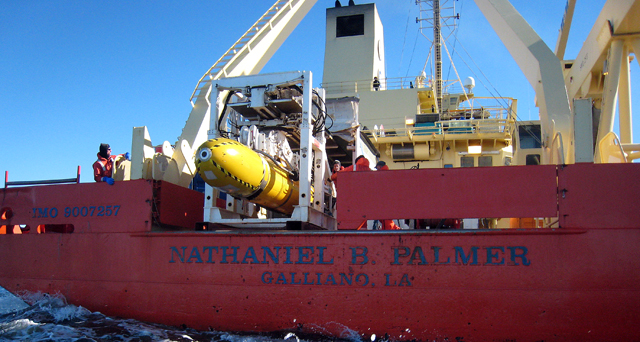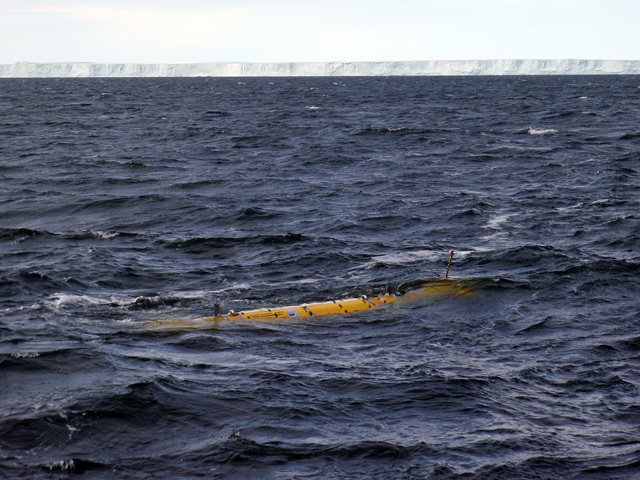Rapid retreatDiscovery of seafloor ridge by robotic sub offers insight into ice loss in AntarcticaPosted June 21, 2010
A robotic submarine, making a rare foray underneath an ice shelf, found an important clue as to why one of West Antarctica’s key glaciers is draining more ice toward the sea in recent years. Scientists already knew that a small ice shelf that fronts Pine Island Glacier in the Amundsen Sea had been thinning for some time. The ice shelf acts as a sort of cork in the wine bottle, preventing the glacier from draining straight into the ocean. But as that “cork” weakens, the ice flows faster, eventually contributing to sea-level rise. An international team of researchers reported this week in the journal Nature Geoscience why that “cork” has loosened so much in recent years: They found a 300-meter-high ridge on the seafloor where the ice shelf was once attached. The retreat of that grounding line — where ice and land meet — since the 1970s toward the continent has allowed relatively warm ocean water to flow over the ridge and into a widening cavity that now extends to an area of 1,000 square kilometers under the ice shelf. The warm water — known as circumpolar deep water (CDW) — is causing the bottom of the ice shelf to melt, resulting in continuous thinning and acceleration of the glacier. The authors said that based on early satellite imagery, the glacier was last in contact with the highest point of the ridge in the early 1970s, when imagery showed a bump in the ice surface that disappeared several years later. “The discovery of the ridge has raised new questions about whether the current loss of ice from Pine Island Glacier is caused by recent climate change or is a continuation of a longer-term process that began when the glacier disconnected from the ridge,” said Adrian Jenkins While atmospheric temperatures in West Antarctica are on the rise around the northern end the Antarctic Peninsula, that wouldn’t explain the thinning of the Pine Island ice shelf. Instead, the culprit is the CDW, which is a few degrees centigrade warmer than the melting point of the ice. The warm water itself is likely a natural phenomenon. However, in recent years, there’s building evidence that suggests changes in atmospheric circulation are pulling more of the CDW onto the Amundsen Sea continental shelf, into its deep, glacially carved troughs and underneath ice shelves, which has accelerated melting. It’s less clear whether these changes in circulation are natural or human-induced. Recent research suggests that increasing temperature differences between the stratosphere and troposphere have increased westerly winds around the continent. In some regions, those winds may pull more of the warmer, deeper water onto the continental shelf and the ice margin. The reason scientists believe atmospheric changes may be linked to human causes is two-fold. First, the ozone hole has cooled the stratosphere, the layer of the atmosphere above the troposphere that people inhabit. Second, the strong greenhouse effect caused by the anthropogenic input of carbon dioxide into the atmosphere has warmed the troposphere. The results published the Nature Geoscience paper come from data collected during a 2009 research cruise aboard the U.S. Antarctic Program’s Nathaniel B. Palmer BAS deployed a robotic sub off the Palmer a half-dozen times, operating it 167 hours, with more than half that time spent underneath the ice shelf. The authors note that the information collected by the sub is unique, accounting for 90 percent of all the data ever collected from automated underwater vehicle (AUV) deployments beneath ice shelves. [See related article: Pine Island cruise.] Jacobs noted that in recent years estimates of Antarctica’s contributions to sea-level rise have changed “from near-zero to significant and increasing.” In fact, the authors note that West Antarctica now accounts for about 10 percent of global sea-level rise. “Now, finding that [Pine Island Glacier’s] grounding line has recently retreated more than 30 kilometers from a shallow ridge into deeper water, where it is pursued by a warming ocean, only adds to our concern that this region is indeed what glaciologist Terry Hughes called the ‘weak underbelly’ of the West Antarctic Ice Sheet,” said Jacobs, a senior research scientist at Lamont-Doherty Earth Observatory at Columbia University The finding was quickly making headlines around the world and setting ripples through the polar research community. The results of the study are already affecting a future project planned at the Pine Island Glacier region, where scientists will drill through the floating ice shelf from the surface to deploy instruments into the ocean cavity to learn more about what is happening between the ice and water interface. “It radically affects our thinking about where to drill and place our ocean profilers, and we are in close communication with the BAS folks about this,” said Robert Bindschadler Bindschadler is the principal investigator (PI) on the Pine Island Glacier Ice Shelf expedition “The retreat of PIG is episodic,” said Bindschadler, who was not involved in the robotic submarine work. “Each ungrounding episode leads to a phase of rapid retreat. We’ve been through one. Continued attack on the ice shelf by warm water will lead to another and another.” NSF-funded research in this story: Stan Jacobs, Adrian Jenkins and Hartmut Hellmer, Columbia University, Award No. 0632282 |



For USAP Participants |
For The Public |
For Researchers and EducatorsContact UsU.S. National Science FoundationOffice of Polar Programs Geosciences Directorate 2415 Eisenhower Avenue, Suite W7100 Alexandria, VA 22314 Sign up for the NSF Office of Polar Programs newsletter and events. Feedback Form |





